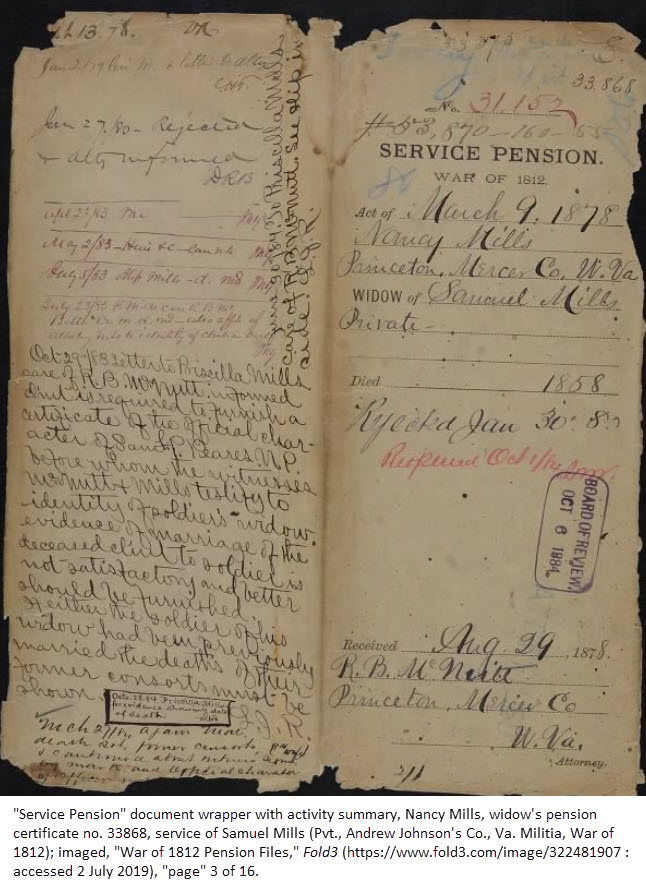
We’ve all heard the advice: full citations should appear on every photocopied or scanned document and every page of a research report. It also matters where, exactly, we place that label.
To avoid altering the face of a photocopy, some researchers place the source label on the blank back side. Many archives do also. We all know what happens, then, as that photocopy goes into circulation. Someone in the circulation chain fails to copy the reverse of the record. From that point on, the document has lost its identity. It's a nameless face, like those old photographs we find in archival collections or an old-timer's shoebox.
When a document has been scanned, some researchers use the scan's cryptic digital-file name—even the URL for an online image— as a quick substitute for a real source label. Let's ignore the obvious for a moment (the identification is not sufficient) and look at the problem that lurks behind that one. As the file is distributed electronically, others in the chain are likely to change the file label to suit their own filing system. Once again, we've lost even those skimpy clues to the original source.
The generally accepted "best practice" today is to use the margin of the image—the front side of the document—to add a citation in full Reference Note format. That way, the document is never separated from its ID. If the margin doesn't give us adequate space, we have technological tools to help us. We can use a photocopier’s reduction feature to decrease the image and enlarge the margin just enough for a source citation. If we're working with a digital scan, we usually find a size-adjustment feature in our image editing software, along with an annotation tool that allows us to type a full citation into the margin of the digital image.
Other problems occur when researchers type their handwritten research notes or reformat notes they had entered into their laptop or mobile device while on site at a repository. To save time, they may identify the archive or library on just the first page of the report. Or, when an abstract runs onto a second page, they may identify the abstract only at its beginning. Once the notes are reduced to hard copy, those sheets of paper will inevitably become shuffled and individual sheets will stray into other files. Even if the data remain in electronic form, any reorganization will likely separate one note from another, creating mystery objects out of some valuable notes.
As the old saw goes: An ounce of prevention is worth a pound of cure!
Labeling original photographs
How should we label an original photpgraph that is printed on a post card? I have received a couple of these from my family. The front contains a nice photograph of family members, and the back contains the writing are of the post card. Some of these have things written in that area, and some do not. With one-sided photos, I know we can write a citatiion lightly on the back of the photo with a soft pencil, but what about these double-sided treasures?
Interesting question, Greg.
Interesting question, Greg. If it were mine, I'd be hesitant to write anything on either side of an original artifact. My approach would probably be this:
Perhaps some of our readers will have other suggestions.
Thanks, Elizabeth
An excellent suggestion. A bit more work, of course, but I'll probably follow tthat route. Thanks again. See you in Richmond!
Document Metadata
Adding a full citation to an electronic document's metadata is also a good way to ensure the citation stays with the document even after it's been renamed.
Dan, that's an excellent back
Dan, that's an excellent back-up to the citation that we put in the margin of the document. That way it's still preserved even if someone decides to photoshop the document and crop off the citation.
Which margin?
Is one margin (top, bottom, left, right) preferable? If so, why?
Emy, which margin we use will
Emy, which margin we use will likely depend upon the space that's available for use. If we're preparing a series to be used together, then (for consistency) an editor would typically advise us to adjust the document size to allow adequate white space in the same position on every document.
How to include a digital photograph document number
I scan the front and back of my photographs and assemble them into one image with the citation at the bottom.
I am now organizing my collection in anticipation of receiving a large batch of photos on loan, so I want to get my documentation workflow process all worked out now.
In order to reference my digitally scanned photographs, I assign a unique number to each (e.g. p000001). I want to include this number in:
1) the digital image file name; and
2) the citation included in the margin on the digital image.
Example filename:
Charles Everett Noble Jr. and VaLois Green on motorcycle (p000001).jpg
Example citation:
Charles Everett Noble Jr. and VaLois Green on motorcycle (p000001) photograph, 13 April 1941; digital image ca. 2015, privately held by Brad Stone, [address for private use,] Provo, Utah, 2015. The original photograph was scanned by Brad Stone and is privately held by Tina C. Noble who received it from her mother Georgette Francoise Fresnault who was married to Charles Everett Noble Jr. The handwriting on the reverse of the photo matches that of Charles Everett Noble Jr. A view in Google Maps Street View of the address 127 North Edgemont St., Los Angeles, California, confirms the building identified in this photo and it is still standing in 2015.
Q1) Given that the name of the photograph contains the image number in parenthesis, would EE consider the citation correct?
Q2) Would EE suggest a different way of representing the document number in the filename and subseqently in the citation?
- Brad